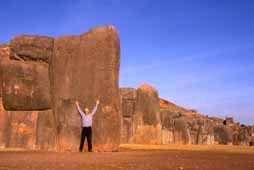 Inca fortress at Sacsayhuamán
Inca fortress at Sacsayhuamán Inca fortress at Sacsayhuamán
Inca fortress at SacsayhuamánIn December 1999 John started his most ambitious journey yet, fulfilling a ten-year-old dream. The Royal Road – so-called because it linked the ancient Inca capitals of Quito and Cusco – follows the spine of the Andes for 1,700 miles through what is now Ecuador and Peru. After the Spanish conquest much of this extraordinary highway fell into disuse, and in his nine-month journey John hoped to find out what became of it.
“It was an explorer’s delight,” he said on his return. “This was the M1 of the Inca empire – so important that Pizarro’s army used it for their march of conquest in 1533. It dives through gorges and climbs to nearly 15,000 feet, but I found long sections in amazingly good condition and still used by local people with their sheep and llamas.”
The trip was full of surprises – volcanic eruptions, floods, snowstorms and a military coup – but helped by friendly inhabitants and sustained by the native Andean potato, he reached his goal and made some unexpected discoveries. “I kept coming across ruined Inca bathrooms,” he says, “meticulously designed with a spout, a drain and even a shelf for the soap. Cold water only though.”
John speaks fluent Spanish
and a little Quechua, the still widely spoken language of the
Incas. Travelling mostly alone and on foot, he pieced together
surviving fragments of the ancient road and quizzed local people
for legends or anecdotes about it. A highlight was finding the
remains of an Inca tambo or staging post, lost since the
1500s, in southern Ecuador. Near Cajamarca in northern Peru he
also spent some time seeing the work of Practical Action,
the charity which he has supported for many years.
